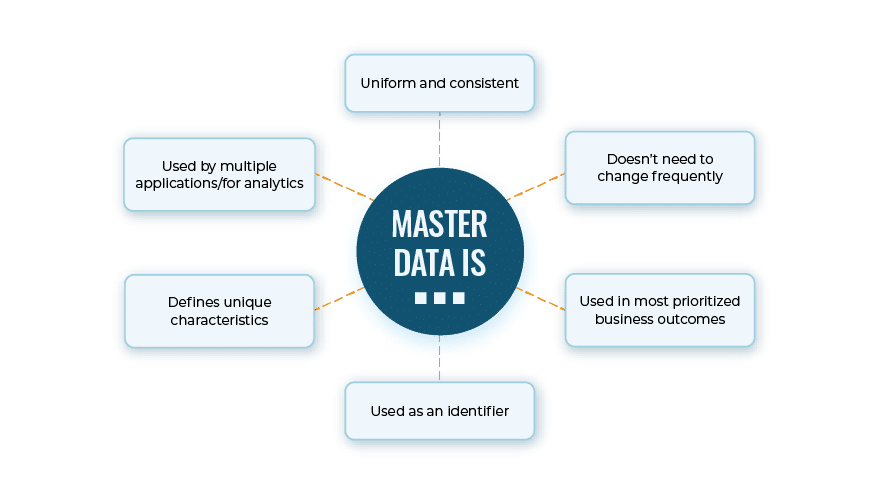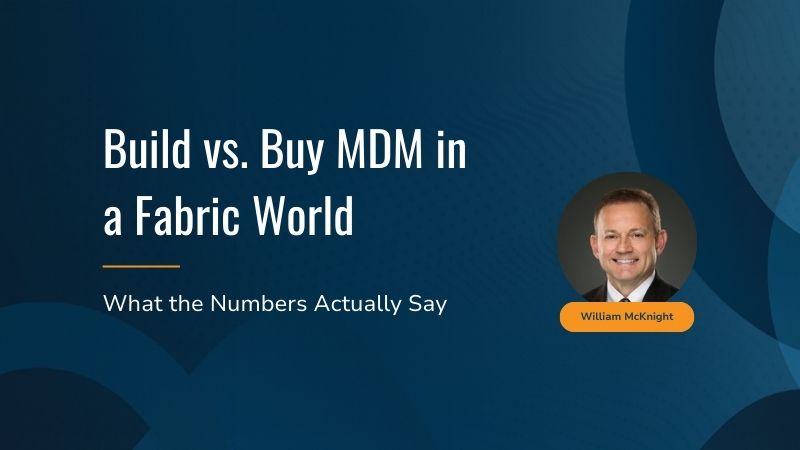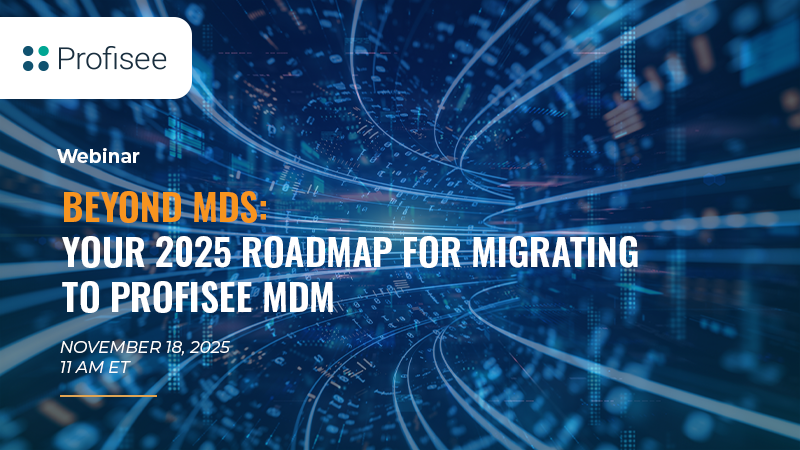Table of Contents
- Master Data vs. Transactional Data
- How Is Transactional Data Managed?
- ACID Properties of Transactional Data
- Interactions Between Transactional and Master Data
- How to Tell the Difference Between Transactional and Master Data
- Fully Understand Your Transactional Data with Profisee
- Other Blog Posts In This Series
Organizations generate many kinds of data that serve different functions and have different processing and management requirements. For many organizations, transactional data is one of the most important types of data alongside master data and reference data. In this article, we’ll explore what exactly transactional data is, how it differs from master data and reference data, how it’s managed and how master data can help complement your understanding of it.

Accelerate Microsoft Fabric Success
Master Data vs. Transactional Data
Spend any time in the world of master data management (MDM), and you’re likely to hear a definition of master data that goes something like this: “Master data is the core, non-transactional business data that is widely shared and rarely changes.” Master data refers to real-world entities like customers, products and locations, or, as we like to say, people, places and things.
Transactional data, on the other hand, is not core business data. It is not usually widely shared, and it changes frequently. TechTarget defines transactional data simply as, “…information collected from transactions,” which can refer to any number of events besides financial transactions:
- Shipping updates on orders
- Hours logged by workers in a timesheet
- Insurance claims
- Prescription orders from a physician
- Bank deposits and withdrawals
- Students registering for classes at a college or university
- Customer support case creation/closure
Generally speaking, transactional data is a record of any event where an exchange takes place. This can quickly become an overwhelming amount of information, so organizations usually choose a few important types of transactional data to focus on, like purchases made and hours worked.
Both master data and transactional data are essential for organizations looking to become more data-driven, especially for initiatives like customer 360. Master data provides useful context around transactional data, and transactional data records often point to master data like customer or product information. For best results, it’s important to properly manage both types of data to ensure they can be trusted for deriving insights.
How Is Transactional Data Managed?
The systems used to manage transactional data are aptly named transactional databases. These are specialized database management tools that excel at processing data rapidly while ensuring that records remain unique, intact, secure and accessible.
Transactional databases form the backbone of major industries such as banking and ecommerce. Without them, it’s difficult to imagine how these industries as they exist today would function. It’s not just that transactional databases must be fast to keep up with the daily onslaught of transactional data — they must also include automation features to cancel or reverse incomplete transactions or transactions that encounter errors in addition to failovers to ensure databases continue reliably processing data in the event of system failures (more on this in the next section).
There are many transactional database tools on the market, but some popular options include relational database management systems (RDBMS) such as:
- Microsoft SQL Server or Azure SQL
- MySQL
- Oracle Database
- MongoDB
- Amazon DynamoDB
- IBM Db2
ACID Properties of Transactional Data
Beyond the definition we considered earlier, transactional databases use a more technical definition of transactional data to determine how transactions should be processed. Known by the acronym ACID, this approach to defining transactions is designed to prevent data loss and consists of four properties:
- Atomicity: Transactions are an all-or-nothing affair, at least from a database’s perspective. Transactional databases usually need to complete a few steps before completing a single transaction. If any one of those steps fails during the process, it could cause inaccuracies in the data. Since ACID was developed to prevent this very thing, transactional databases are engineered to only consider a transaction successful if every step of the operation is successful.
- Consistency: Databases have rules! Transactions must adhere to the rules organizations put in place, and it’s the database’s job to make sure this happens. For instance, an ecommerce company might have business rules in place to prevent purchase transactions on products that are out of stock or that aren’t available for delivery to a certain region.
- Isolation: Sometimes, more than one transaction needs to interact with the same data simultaneously. The isolation property of ACID ensures this happens in an orderly fashion and that concurrent transactions don’t devolve into free-for-alls of one operation attempting to, for example, read a data record while another operation is trying to move it somewhere else or replace it. Rather, this property says that concurrent transactions must be processed one at a time; the database must finish processing the transaction it’s currently working on before it can move on to the next one.
- Durability: Once the database successfully completes a transaction, that record is permanently saved. Even if there’s a system failure — for example, as in the event of a power outage — transactional data that meets ACID standards won’t be lost.
Maintaining the integrity of transactional data is critical — especially for highly regulated industries like banking and finance that may need to preserve data integrity as a matter of regulatory compliance. ACID properties help ensure that databases handle transactions properly to achieve that goal.
Interactions Between Transactional and Master Data
We know that part of what makes master data master data is that it’s non-transactional, but what happens when master data and transactional data cross paths? This happens all the time, and it’s a normal and often necessary behavior for these different types of data to exhibit.
Consider what happens when a manufacturer, for example, places an order with one of its suppliers. The manufacturer sends a request for raw materials, money is exchanged and then the supplier creates a purchase order and gets to work on fulfilling the order. The transactional data record in this example might look like this:
| Order Number | 025896 |
|---|---|
| SKU | HXN017 |
| Customer ID | RW-184-CON |
| Sale Amount | $12,435.00 |
| Sale Date | 10/25/2024 |
| Sale Time | 14:28:15 |
| Card Number | XXXXXXXXXXXX5673 |
This is a transaction record, but only some of the record attributes would be considered transactional data:
- The order number (025896)
- The sale amount ($12,435.00)
- The sale date and time (10/25/2024, 14:28:15)
The other attributes of this record represent different kinds of data that the transactional data is referencing:
- The SKU number (HXN017) is product master data
- The customer ID (RW-184-CON) is customer master data
- The card number (XXXXXXXXXXXX5673) is reference data, itself a subset of master data
Here, the transaction refers to master and reference data, but the database performing the operation is not responsible for maintaining that data. Rather, the database is basically pointing to that data while a master data management (MDM) tool like Profisee ensures it stays accurate, up-to-date and consistent. The MDM tool serves as the single source of truth for the master data and reference data, making it accessible to downstream systems, such as the transactional database in this example.
How to Tell the Difference Between Transactional and Master Data
By now you probably have some sense of what constitutes transactional data, but just to make sure you have a clear understanding of the difference between master data and transactional data, let’s look at some common attributes of master data and consider some examples of both master and transactional data.

Common Master Data Attributes
A single master data record may have hundreds of attributes that provide context depending on the industry, but data is only considered master data when it meets the following criteria:
- Does the attribute value need to be consistent and uniform? Master data attributes must be consistent across the organization. For example, data about product dimensions or weights should follow a standardized format, like centimeters or ounces, to ensure uniformity across systems.
- Is the data used as an identifier? Identifiers such as a customer ID or stock keeping unit (SKU) are crucial for tracking and managing data records about customers and products. Such identifiers should be unique and consistent to avoid errors in inventory, sales, billing and distribution processes.
- Does it define unique characteristics? Unique characteristics of products, for example, such as color, size, material or model number, are essential product master data attributes that distinguish one item from another and are critical for accurate cataloging and customer selection.
- Does the attribute value need to change frequently? Master data attributes remain relatively stable over time. For example, the location of a customer’s headquarters is not likely to change often, if ever. By contrast, attributes like the number of opportunities with a given customer change regularly and are not considered master data.
- Is it used often by multiple operational applications and for analytics? Master data is typically used across various departments, such as supply chain, marketing and sales. For instance, accurate product information is vital for inventory management, marketing campaigns and sales forecasting. Product data might also be shared externally, such as with suppliers or partners.
- Is the data used in most, if not all, prioritized business outcomes? This criterion ensures that the most impactful data is prioritized in your MDM efforts. For example, focusing on maintaining accurate hours of operations across retail locations may have a direct impact on increasing sales and improving customer satisfaction.
Examples of Master Data and Transactional Data
Real-life examples of master data and transactional data differ across industries. Consider the following examples pertaining to product data across several different industries.
Energy
| Master Data | Generally Non-Master Data |
|---|---|
| Asset Tag (e.g., Wind Turbine, Solar Panel) | Energy Output Metrics |
| Operational Specifications | Maintenance Schedules |
| Fuel Type (e.g., Oil, Natural Gas) | Real-time Energy Demand |
| Equipment Life Cycle | Carbon Emissions During Operation |
Healthcare
| Master Data | Generally Non-Master Data |
|---|---|
| Medical Device Serial Number | Patient Usage Data |
| Medication Dosage | Prescription Refills |
| Product Expiration Date | Inventory Turnover Rate |
| Regulatory Compliance Information | Insurance Claims Processed |
Manufacturing
| Master Data | Generally Non-Master Data |
|---|---|
| Bill of Materials (BOM) | Production Line Downtime |
| Part Number | Machine Operating Hours |
| Assembly Instructions | Yield Rate |
Supplier Information | Defect Rate for a Specific Batch |
Fully Understand Your Transactional Data with Profisee
With Profisee’s adaptive, cloud-native MDM platform, it’s easy to manage master data for consistent reference by your transactional databases. Integrate data from sources like your CRM or ERP and use Profisee’s advanced fuzzy matching capabilities to identify and merge similar records for the most complete picture of data.
Profisee works with your existing data governance tools to enforce governance policies, improving data quality and standardizing master data for use by downstream systems, including relational database management systems like Oracle and SQL Server.
Other Blog Posts In This Series

Eric Melcher
Eric has spent the entirety of his 15+ year career working in the enterprise information management space. As Chief Technology Officer, Eric is responsible for all aspects of product management, development and support for Profisee’s software portfolio.











